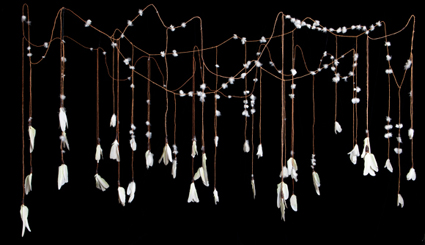Some of my favourite works were the life size sculptures by Niningka Lewi, Minya Punu Kungkarangkalpa (The Seven Sisters),2013. They were made from grasses and other fibres and were marvelously animate and colouful. I thought they were great and it looks like the kids in the image below thought so too.


There was a collection of strings made from traditional materials bark fibre and feathers, strong and delicate. The work below is by Frances Djulibing, Yukuwa (Feather string yam vine), 2013 made from banyan tree bark, cockatoo feathers and beeswax. This was a large suspended installation was wafted delicately as you moved around it.


The painting below was traces the twining patterns found in dilly bags. It is by Regina Wilson, Wagardi (Dilly Bag), 2010.

The work below is by Dale Harding, Bright Eyed Little Dormitory Girls, 2013, one of a series in the installation.

In the video you get a glimpse of a series of lace collars with leather which really grabbed me in the heart. I'm afraid it reminded me of Roebourne Prison which I visited a few years ago and found it a very traumatic experience. I'm sure the work referenced young Aboriginal girls being forced to work as house maids but for me it had overtones of the terrible neck chains used on Aboriginal prisoners .
 |
There was a series of colourful artline works by Jimmy Pike all part of the UWA Berndt Museum collection which I thoroughly enjoyed . 'Headband', illustrated above gives an idea of the richness of his work. Coincidentally I am reading You Call it Desert - We Used to Live There by Pat Lowe with Jimmy Pike. This book describes life in the Great Sandy Desert as lived by small family bands before the arrival of kartiya (white people) and the changes to the land and cultural practices since then. It covers things like waterholes, tools, medicine, children's games, birth and death, and the Walmajarri language. The easy to read text is complemented by many photographs and Pike's drawings and paintings.
It was a great show and I thoroughly enjoyed it - the only downside was that the catalogues had sold out - good for PICA bad luck or me. Coincidentally I subsequently met the photographer responsible for the images for the catalogue while minding the Butter Factory Gallery down here. She said the artists had some amazing stories to tell, particularly the stories associated with the dolls. (The video gives a glimpse of the collection. I tried to embed the video but couldn't make it work so you need to follow the link.)
It was a great show and I thoroughly enjoyed it - the only downside was that the catalogues had sold out - good for PICA bad luck or me. Coincidentally I subsequently met the photographer responsible for the images for the catalogue while minding the Butter Factory Gallery down here. She said the artists had some amazing stories to tell, particularly the stories associated with the dolls. (The video gives a glimpse of the collection. I tried to embed the video but couldn't make it work so you need to follow the link.)
I wrote this on the tenth but for some reason didn't publish it, so here it is now.
All images from the PICA website and PICA Facebook or the UWA Berndt Museum website..
No comments:
Post a Comment